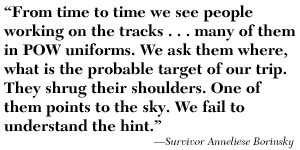
|
|
|

|

|

|

|
|
Click on an image to see a larger, more detailed picture.
|
|
|
|
|
| 1943: Death and Resistance |

|
pg. 482 |

|
|
|
|
| |

|
 Riga was Latvia's largest Jewish center. With the German occupation of Latvia in July 1941, thousands of Jews were murdered and 30,000 sealed off in the Riga Ghetto. In late 1941 the eminent Jewish historian Simon Dubnow was murdered along with most of the city's surviving Jews. Repopulated by German Jews, the Riga Ghetto was finally destroyed in November 1943.
Riga was Latvia's largest Jewish center. With the German occupation of Latvia in July 1941, thousands of Jews were murdered and 30,000 sealed off in the Riga Ghetto. In late 1941 the eminent Jewish historian Simon Dubnow was murdered along with most of the city's surviving Jews. Repopulated by German Jews, the Riga Ghetto was finally destroyed in November 1943.
Photo: Yad Vashem / United States Holocaust Memorial Museum Photo Archive
|
 Even music was subverted by the Nazis. To calm arrivals and delude them into thinking that they were in a safe haven, the Auschwitz-Birkenau camp orchestra played cheerful and familiar melodies as people descended from the trains. Music also provided a macabre accompaniment to death, as shown in this photo from Mauthausen. Prisoners are marched to the gallows while accompanied by the violins and accordion of the camp orchestra. The inmates referred to this as the Symphonia Diabolica, the Devil's Symphony.
Even music was subverted by the Nazis. To calm arrivals and delude them into thinking that they were in a safe haven, the Auschwitz-Birkenau camp orchestra played cheerful and familiar melodies as people descended from the trains. Music also provided a macabre accompaniment to death, as shown in this photo from Mauthausen. Prisoners are marched to the gallows while accompanied by the violins and accordion of the camp orchestra. The inmates referred to this as the Symphonia Diabolica, the Devil's Symphony.
Photo: Deutche Presse/Archive Photos F1159P7
|
|

|

|

|

|
 September 26, 1943: At the Novogrudok, Belorussia, labor camp, Jews complete secret work on a tunnel dug under the wire. Of the 220 Jews who use the tunnel to attempt escape, 120 are killed or captured.
September 26, 1943: At the Novogrudok, Belorussia, labor camp, Jews complete secret work on a tunnel dug under the wire. Of the 220 Jews who use the tunnel to attempt escape, 120 are killed or captured.
|
 September 28-29, 1943: Five thousand Jews from Amsterdam are deported to the Westerbork, Holland, transit camp.
September 28-29, 1943: Five thousand Jews from Amsterdam are deported to the Westerbork, Holland, transit camp.
|
 September 28-29, 1943: The Jewish community from Split, Yugoslavia, is killed at the Sajmiste, Yugoslavia, concentration camp.
September 28-29, 1943: The Jewish community from Split, Yugoslavia, is killed at the Sajmiste, Yugoslavia, concentration camp.
|
 September 28-29, 1943: Roman Jews deliver 50 kilograms of gold to the Gestapo in Rome, as ordered. Pope Pius XII had offered to lend the Italian Jews 15 kilograms of gold if they could not collect the full amount themselves.
September 28-29, 1943: Roman Jews deliver 50 kilograms of gold to the Gestapo in Rome, as ordered. Pope Pius XII had offered to lend the Italian Jews 15 kilograms of gold if they could not collect the full amount themselves.
|
|
|
|
|
| 1943: Death and Resistance |

|
pg. 482 |

|
|
The Holocaust Chronicle
© 2009 Publications International, Ltd.
|
|
